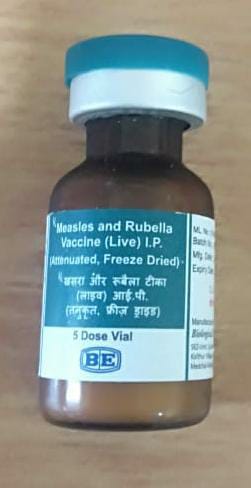Measles vaccine
Measles Vaccine[edit]

Overview[edit]
The measles vaccine is a highly effective immunization tool against measles, a highly contagious viral disease. It is a cornerstone in public health initiatives worldwide due to its efficacy and role in measles eradication efforts.
Development and Types[edit]
The measles vaccine was developed in the 1960s and has undergone several advancements since. There are different types of measles vaccines, including monovalent (measles only) and combination vaccines like MMR (measles, mumps, and rubella).
Efficacy and Immunity[edit]
- Initial Dose: A single dose of the measles vaccine is highly effective in developing immunity in most individuals.
- Second Dose: For those who do not develop immunity from the first dose, a second dose almost always ensures immunity.
- Longevity of Immunity: The vaccine's effectiveness is known to last for many years, although the exact duration of immunity is still under study.
Herd Immunity and Outbreak Prevention[edit]
- Herd Immunity Threshold: When vaccination rates in a population exceed 92%, herd immunity is achieved, significantly reducing the likelihood of measles outbreaks.
- Importance of Vaccination Rates: Maintaining high vaccination rates is crucial to prevent the resurgence of measles outbreaks.
Vaccine Administration[edit]
The measles vaccine is typically administered in childhood as part of routine immunization schedules. It is often combined with mumps and rubella vaccines (MMR) for broader protection.
Post-Exposure Efficacy[edit]
In some cases, administering the measles vaccine within a couple of days after exposure to the measles virus can provide protection against the disease.
Safety and Side Effects[edit]
The measles vaccine is generally safe, with side effects being rare and usually mild, such as fever or mild rash. Severe side effects are extremely rare.
Global Impact[edit]
The widespread use of the measles vaccine has led to a significant decline in measles cases and fatalities globally, playing a pivotal role in public health.
Challenges and Future Directions[edit]
Despite its success, challenges such as vaccine hesitancy and access in remote areas persist. Continuous efforts are needed to maintain high vaccination coverage and move towards global eradication of measles.
See Also[edit]
References[edit]
Ad. Transform your life with W8MD's Budget GLP-1 injections from $75


W8MD offers a medical weight loss program to lose weight in Philadelphia. Our physician-supervised medical weight loss provides:
- Weight loss injections in NYC (generic and brand names):
- Zepbound / Mounjaro, Wegovy / Ozempic, Saxenda
- Most insurances accepted or discounted self-pay rates. We will obtain insurance prior authorizations if needed.
- Generic GLP1 weight loss injections from $75 for the starting dose.
- Also offer prescription weight loss medications including Phentermine, Qsymia, Diethylpropion, Contrave etc.
NYC weight loss doctor appointmentsNYC weight loss doctor appointments
Start your NYC weight loss journey today at our NYC medical weight loss and Philadelphia medical weight loss clinics.
- Call 718-946-5500 to lose weight in NYC or for medical weight loss in Philadelphia 215-676-2334.
- Tags:NYC medical weight loss, Philadelphia lose weight Zepbound NYC, Budget GLP1 weight loss injections, Wegovy Philadelphia, Wegovy NYC, Philadelphia medical weight loss, Brookly weight loss and Wegovy NYC
|
WikiMD's Wellness Encyclopedia |
| Let Food Be Thy Medicine Medicine Thy Food - Hippocrates |
Medical Disclaimer: WikiMD is not a substitute for professional medical advice. The information on WikiMD is provided as an information resource only, may be incorrect, outdated or misleading, and is not to be used or relied on for any diagnostic or treatment purposes. Please consult your health care provider before making any healthcare decisions or for guidance about a specific medical condition. WikiMD expressly disclaims responsibility, and shall have no liability, for any damages, loss, injury, or liability whatsoever suffered as a result of your reliance on the information contained in this site. By visiting this site you agree to the foregoing terms and conditions, which may from time to time be changed or supplemented by WikiMD. If you do not agree to the foregoing terms and conditions, you should not enter or use this site. See full disclaimer.
Credits:Most images are courtesy of Wikimedia commons, and templates, categories Wikipedia, licensed under CC BY SA or similar.
Translate this page: - East Asian
中文,
日本,
한국어,
South Asian
हिन्दी,
தமிழ்,
తెలుగు,
Urdu,
ಕನ್ನಡ,
Southeast Asian
Indonesian,
Vietnamese,
Thai,
မြန်မာဘာသာ,
বাংলা
European
español,
Deutsch,
français,
Greek,
português do Brasil,
polski,
română,
русский,
Nederlands,
norsk,
svenska,
suomi,
Italian
Middle Eastern & African
عربى,
Turkish,
Persian,
Hebrew,
Afrikaans,
isiZulu,
Kiswahili,
Other
Bulgarian,
Hungarian,
Czech,
Swedish,
മലയാളം,
मराठी,
ਪੰਜਾਬੀ,
ગુજરાતી,
Portuguese,
Ukrainian


